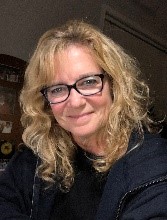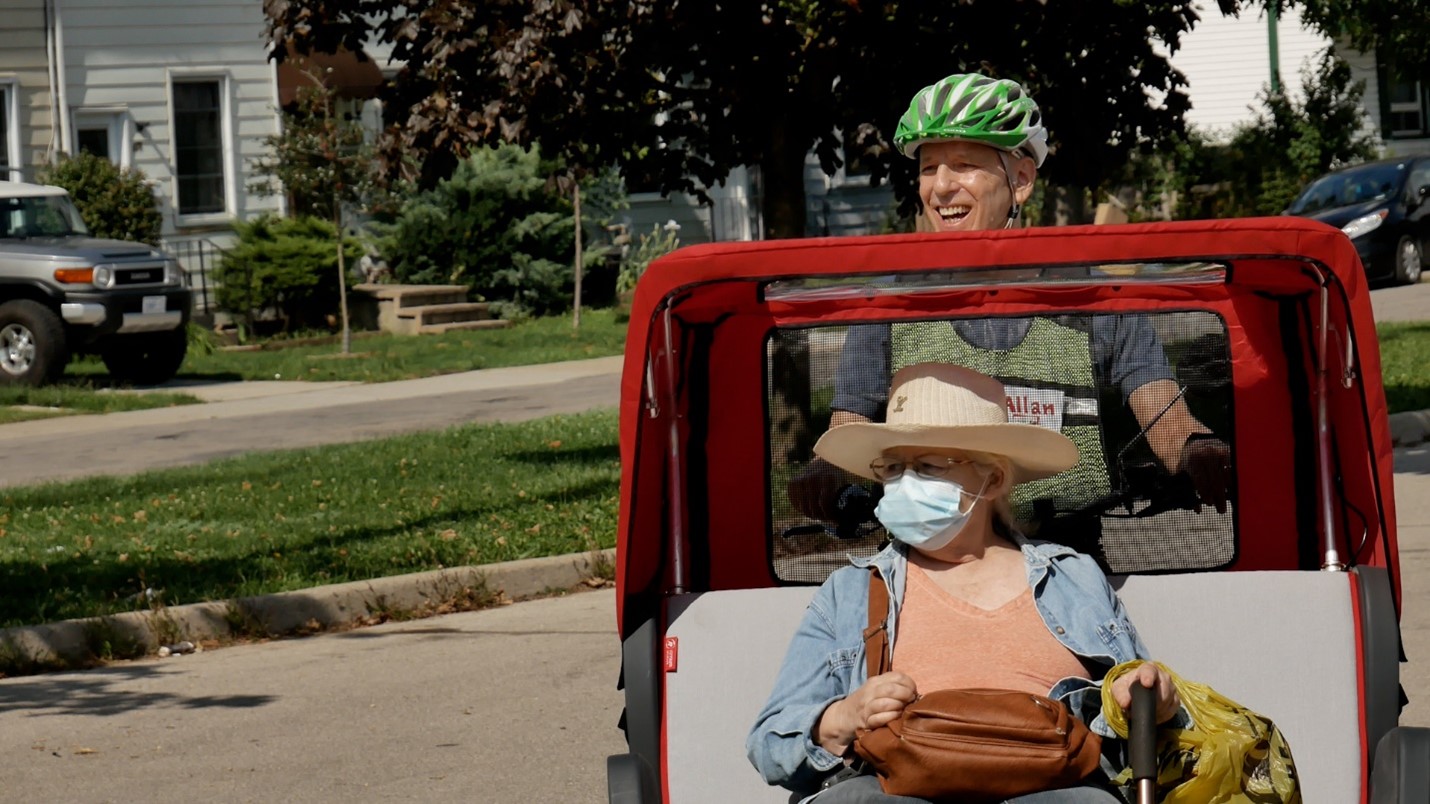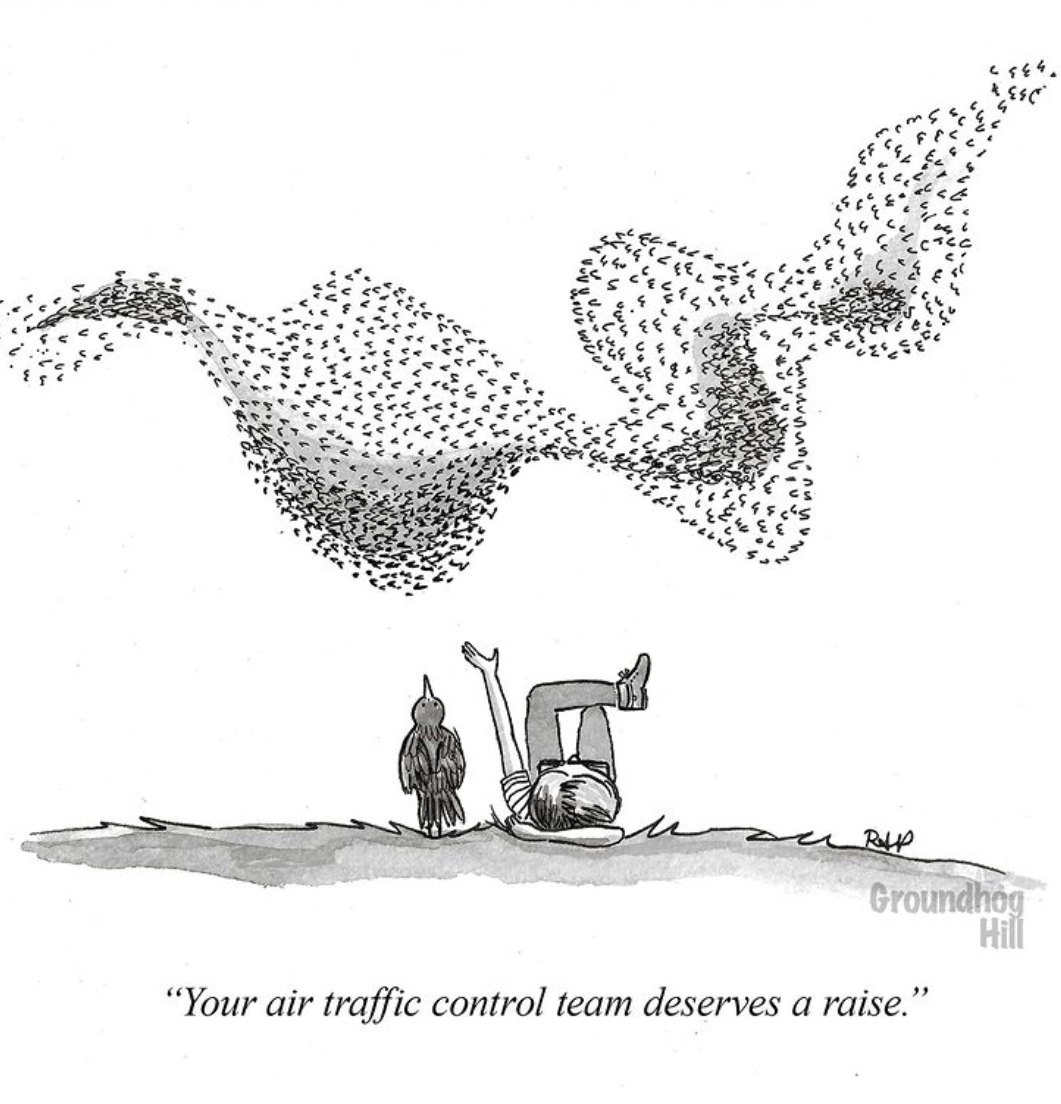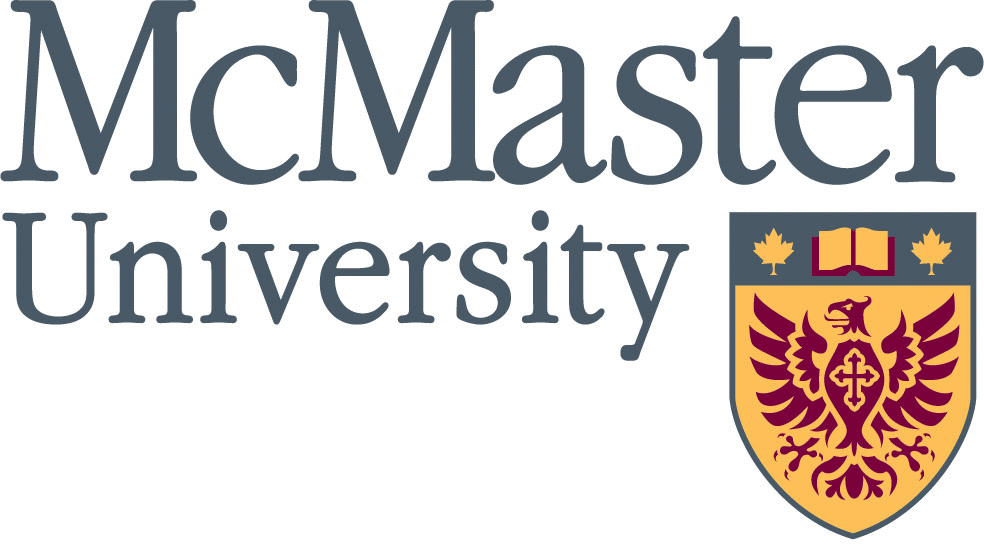- Home
- MURAnews
- Previous issues
- Spring 2017 - present
- Fall 2021
MURAnews Fall 2021
MURAnews Fall 2021 issue in PDF format
In this issue:
 Retirees often contact us about pension matters. This is also a topic that occupies a major amount of time for MURA’s council and executive. Broad questions include ones on the sustainability of our pension plans and others on the availability of yearly increases to cope with the rising cost of living. We and our beneficiaries can expect to live longer than our parents. Making it into our 90s is not an unreasonable expectation. Retirees often contact us about pension matters. This is also a topic that occupies a major amount of time for MURA’s council and executive. Broad questions include ones on the sustainability of our pension plans and others on the availability of yearly increases to cope with the rising cost of living. We and our beneficiaries can expect to live longer than our parents. Making it into our 90s is not an unreasonable expectation.Will the Salaried Pension Plan be able to meet the expectations of its members? The answer is yes if our funds are well-managed to produce the surplus needed, and if administrative expenses are carefully limited. On the positive side the financial investments in the Plan generally have produced the proper income. Historically at McMaster the issue of admissible administrative expenses and other deductions from the pension fund have been a source of important disagreement, especially in the 1990s. An important agreement to resolve this occurred in 1998. A Memorandum of Understanding (MOU) between the University and the five largest employee associations agreed on the allowable deductions from the pension trust, the equal weight of the university administration and associations representing present and retired employees, and the decisions that would breach the agreement. The 1998 MOU has been a great success. The Salaried Pension Plan has performed well and the tensions of the early 1990s have given way to more comfortable relations in general, at least on pension matters. However, over the past year the university administration has indicated that it would like to retire the MOU and replace it with a new policy that would include the ability of the University to deduct additional administrative expenses from the pension funds. As well, the administration proposes to remove the right of the employee associations to agree or disagree with the deductions of new expenses. This presents a number of problems. First of all, such changes would make it difficult for the university administration to keep separate its role as employer versus its role as pension plan manager. With any pension plan it is always important to control a conflict of interest by the plan administrator. The consent of employee associations with 50 per cent of the support needed for major changes works to remedy any attempts at improper deductions from the pension funds. The administration now wants to remove the employee associations as the legitimate representatives of employees, past and present. The group of associations that represent the plan beneficiaries are one of two parties that have a fiduciary interest in the pension funds. The other party is the plan administrator, the university administration. Historically, employees and their associations have tended to agree with the administration that, in allocating the total yearly compensation budget, the first payee should be the pension plan. This risk-averse behaviour resulted in the enhanced sustainability of the pension funds and the likelihood of good surpluses. The accepted drawback is that at times there has been under-compensation for rising cost-of-living salary increases, low salary acknowledgement of yearly increases for employees’ skills, and a lack of reasonable compensation for meritorious performance. As a result, the yearly salary increases were often below salary increases for the same positions generally in Hamilton, and below the increases at the other large, major universities in Ontario and Canada. The 1998 MOU does not need to be retired. There is no reason why an additional MOU cannot be agreed upon to deal with new issues that have arisen since 1998. The foresight of the 1998 administration and the 1998 employee associations has produced consensus decision-making, a welcome change from the disputes of the early 1990s. We should build on this success and avoid throwing out the baby with the bath water. We look forward to working with representatives of the employee association signatories to the 1998 MOU and the university to reach a mutually agreeable arrangement for the governance of pension plan expenses.
McMaster Alumni Learning WebinarsBy Nora Gaskin
I was browsing through my emails last spring, when one from McMaster University Alumni about their upcoming series of webinars caught my eye. Nir Eyal, international bestselling author, speaker, behavioral design expert, and author of Indistractable: How to Control Your Attention and Choose Your Life, was presenting a free webinar outlining the principles in his latest book. I signed up and got an email with a link. On the day and time of the webinar, I tuned in for a fascinating talk about how we get distracted from achieving our goals, with practical strategies to combat that distraction and maintain our focus.
|
 |
|
photo courtesy of McMaster University |
The Back to Mac web site is clear that people who are not fully vaccinated or who have symptoms of COVID-19 (regardless of vaccination status) must not enter buildings at any McMaster location. The web site provides detailed information for visitors to campus, including retirees. Visitors must provide proof of full COVID-19 vaccination at least one hour before their first time attending a McMaster location. You will need to obtain McMaster SafetyApp/MacCheck approval if you intend to be inside a building at a McMaster location for a period of more than 15 consecutive minutes or for a total of at least one hour during a 24-hour period. The Back to Mac web site does note an exception for members of the public coming to a McMaster location and staying outside only, for example to enjoy a walk outside. In this case, visitors do not need to provide proof of COVID-19 vaccination.
To register your vaccination status, download the McMaster SafetyApp from the App Store/Google Play Store on any internet-connected Apple or Android device, select “MacCheck: Your COVID-19 Digital Tool” from the opening page of the app, and register your vaccination status. Visitors may also register with the SafetyApp via any website browser. Clicking this link will take you to a web page headed MacCheck where you should choose the option at the bottom of the page: “I am a Visitor, Volunteer, Contractor, Retiree or Alumni attending University Property.” After your information is reviewed, you will be issued with a QR code in the SafetyApp on your phone or tablet. After completing the MacCheck form online, individuals without a smart phone or tablet will be sent a copy of their QR code by email. They may print this and bring a paper copy with them when visiting campus.
When visiting a McMaster building, you should be prepared to show your “Vaccine Passport Status”, with its QR code, in the McMaster SafetyApp on your phone or tablet (or on paper if you do not have a device). It is particularly important to be prepared to show your McMaster SafetyApp approval in settings where people are interacting in student service areas or for one-on-one appointments. You will not be required to show your McMaster SafetyApp approval to enter campus or a campus building. There will not be random checks for McMaster SafetyApp approval in open and common areas of campus.
MURA members who have questions or need support to complete their vaccine registration should contact the Vaccination Validation Team at vacc@mcmaster.ca.
P.S. If you were in the habit of using the Pulse Fitness Centre before the pandemic, you should be aware that although the Pulse re-opened on July 26th it is operating at reduced capacity and access is limited to students. At the time of writing, on-site exercise programs at the Physical Activity Centre of Excellence (PACE), which include MacMS-FITT, MacWarriors, MacCardiac, MacSeniors and MacWheelers, are closed until further notice. PACE is, however, open for in-person physiotherapy appointments and is offering virtual exercise classes via Zoom through the LIVE AT HOME! Program. To find out more, visit https://pace.mcmaster.ca.
News from MURA
 MURA Graduate Scholarship Fund Update
MURA Graduate Scholarship Fund Update
(It’s time to consider your year-end donation)
MURA’s current academic awards initiative will provide a $1,000 annual scholarship to a graduate student researching technological advances related to seniors. The goal is to establish a $25,000 endowed fund to support this scholarship as soon as possible.
The fundraising drive was launched in November 2020 and has reached $11,000, thanks to the retirees and friends of MURA who have made gifts.
Please give generously to this fund. Donate online at MURAscholarship.ca, or by phone at (905) 525-9150, extension 24224.
Your donations are tax deductible and will help McMaster graduate students for years to come.
MURA members have been supporting academic awards since 1992. A fully-funded endowment continues to provide an annual $2,500 in-course scholarship and a $750 graduand prize to undergraduate students studying society’s aging population. The new graduate scholarship will add to MURA’s legacy of student support.

Welcome new members
compiled by Kathy Overholt
Gloria Billeci, Psychiatry
Asghar Bokhari, Computing & Software
Roberta Downard, Office of the Registrar (Admissions)
Christopher Erskine, Health Sciences Library
Janice Flynn, Custodial Services
Kris Gadjanski, University Advancement
Marjorie Geroux, Earth, Environment & Society
Joanne Leeming, Nursing
Joan Murphy, Medicine
Tracey Oliphant, Psychiatry
Alice Pidruczny, Nuclear Reactor
James Reaper, Maintenance Services
Gina Robinson, Student Affairs
Anne Savage, English & Cultural Studies
Marija Skacan, Custodial Services
Ada Smith, Medicine
Krysia Steinberg, Nuclear Reactor
Kathrine Stewart, Medicine
Hase Williams, Utilities Services
Recent passings
Marjorie Coit, Library Administrative Services, Aug 4/21
Peter Dent, Pediatrics, Sept 23/21
Sadie Love, Human Resources, Aug 4/21
David Muir, Medicine, Aug 9/21
Gertrude (Trudy) Shwedyk, Financial Services, Sept 22/21
Devendra (Dave) Verma, Family Medicine, Sept 23/21
CANCELLED - MURA Holiday Lunch
Due to the uncertainty of COVID restrictions for large on-campus events, MURA Council has decided to cancel the Holiday Lunch originally scheduled for December 7, 2021.
|
 |
Members' Corner
Becoming a Published Novelist, Retirement Dream Come True
By Sue Jaskula
 I have always loved writing and credit my grade twelve English teacher for telling me I was good at it. I hold a Bachelor of Arts Degree in English and a Creative Writing Certificate both from McMaster University. My career has spanned many years in a mix of criminal and civil law and hospital surgical administrative work. This experience has provided a wealth of storyline and character ideas from kind-hearted colleagues to real life murders and evil doers whom I am happy to kill off … in my books!
I have always loved writing and credit my grade twelve English teacher for telling me I was good at it. I hold a Bachelor of Arts Degree in English and a Creative Writing Certificate both from McMaster University. My career has spanned many years in a mix of criminal and civil law and hospital surgical administrative work. This experience has provided a wealth of storyline and character ideas from kind-hearted colleagues to real life murders and evil doers whom I am happy to kill off … in my books!
I was thrilled to have the opportunity to retire in 2018 from McMaster University’s Department of Surgery and pursue a career in writing, a pursuit I have entered with energy and enthusiasm. Having the chance to promote myself as a published Canadian author is humbling and certainly a dream I never expected to realize. I have learned so much on my journey and connected with authors worldwide through social media and through memberships with Toronto Romance Writers, Crime Writers of Canada, and Sisters in Crime.
Rarely lost for words, I was speechless when I received my first contract from New York publisher, The Wild Rose Press. I have since released my debut romantic suspense All Fired Up, in May of this year, which follows the story of a respected Crown Attorney, whose life is shattered when she is accused of murdering her ex. Romance ignites when her childhood friend tries to help prove her innocence.
My second novel Unexpected Connection launched in July and reintroduces the investigating homicide detective from book one. It is a good twin/evil twin police procedural with a sweet office romance and some nasty unexpected connections you will not see coming.
My third manuscript, Death at Dawn, is currently in the editing, cover art process, and releasing soon. A bit darker, it follows two love stories, and involves a small-town bar owner and a dead body in the lake - all fictitious, I promise!!
Finally, my fourth story is a work in progress, and possibly my favourite so far. Although another romantic suspense, it is completely different from the others. It goes back to 1945, post WWII, and takes place on the shores of Lake Huron. I have had fun researching this one with a few old-timers who have lived in Kincardine since before the war.
I write romantic suspense because I love a plot with lots of action, intrigue and twists that draw me in and keep me on the edge of my seat, but I also love love. The crossover of the two genres has always been my go-to. I create independent, confident heroines to challenge my sexy, strong heroes and even though they struggle through murder and mayhem, you can always count on a happily ever after. I truly miss my characters when I step away from writing scenes and even more so once I finish their story.
My husband and I share our home in Grimsby with our youngest daughter, her boyfriend, our dog and two cats! But I spend a great deal of time in my home away from home, at our cottage in Kincardine, Ontario near my daughter, son-in-law and first grandson. On these shores of Lake Huron, with some of the best sunsets, thunderstorms and walking trails in the country, my imagination soars and my best stories come to life.
I am very excited to share my first two romantic suspense novels for quick autumn reads. Both are available at all online retailers worldwide including Amazon, Chapters Indigo, Barnes and Noble, Kobo, Kindle and Apple Books.
I invite readers, fellow authors and fellow retirees to follow or message me on Instagram @suejaskulaauthor or Facebook @sue.jaskula or check out my website for news on upcoming stories. I love hearing from readers!
Buy Nothing Project
By Kenrick Chin
(Kendrick retired in 2019 as a lab technician from the departments of Engineering Physics and Physics & Astronomy.)
Are you thinking of downsizing or simply organizing and decluttering your space? Then this is the perfect avenue for doing so. There is no buying or selling, no money exchanged. You simply post a photo and a short description of the item you have to give away. Within minutes or maybe hours you can be almost certain that someone will be happy to come and take it away from your doorstep.
How would it feel to be an active participant in acts of random kindness on a daily basis? That is the basis and philosophy of the Buy Nothing Project. Started in 2013 in Washington State, this local community project has become a worldwide social movement with groups in 44 countries.
Buy Nothing Dundas was launched in February 2021 in the midst of the pandemic. Within four days more than 380 members had joined. Six months later membership has grown to over 1300 members and continues to grow in popularity.
How it works
Buy Nothing - is a Facebook group. You need to have internet access and a Facebook account. In order to participate you have to join the group in your local area. Membership beyond your catchment area is not allowed. Items posted and “gifted” are for personal use and not for resale. It is entirely up to the gifter to choose who will be gifted the item. Most members choose names at random. Some select the first member who responded. Once the recipient has been selected the gifter and recipient will communicate via private messages in order to arrange for pickup. Usually, items are left outside of the house for the recipient to retrieve. A gifter may have multiple items to be picked up and hence will package
each item with the name of the intended recipient. Once an item is “gifted” the description on the Facebook page needs to be edited to say, “Gifted to ...name...”.
The Buy Nothing Project fulfills a number of environmental, social, and economic concerns. Firstly, it diverts waste from our landfills. Secondly, it puts into action our need to practice the 3 R’s: Reduce, Reuse, Recycle. Thirdly, it helps individuals and families who may be stretched financially. The gifter receives a feeling of goodwill and satisfaction to know that they have given a gift to someone without an expectation of reward. Lastly, it is a great way to build a sense of community.
Links
Buy Nothing Project website
Buy Nothing Dundas Facebook page
Dundas Star News article

 |
|
courtesy of Meanwhile in Canada |
Current Trial of Online Health Self-Management Support for Patients with Chronic Illnesses
By Norm Archer, Professor Emeritus, DeGroote School of Business
Chronic diseases account for 73% of all global deaths, with half of these deaths due directly or indirectly to one or more of high blood pressure, high blood glucose, smoking, and high body mass index. The impact of many of these disorders could be mitigated through proper attention to achieving and maintaining healthy lifestyles. There have been successes in the use of online systems to help patients adopt healthier lifestyles. Although results have been promising, there has been less attention to underlying and inter-related factors that can strongly affect the success of such online approaches, including:
- The lack of cost estimates which, in the long run, play a major role in whether the proposed applications are ever permanently implemented;
- Long-term sustainability of relevant programs in terms of patient recruitment and retention strategies;
- Patient adherence to programs for change;
- Keeping self-management patient motivation high;
- Achieving habit and behaviour change, essential to improving health lifestyles;
- Encouraging social relationships to reduce social isolation and loneliness, which can impose medical risks on individuals;
- Dealing with psychosocial patient characteristics such as depression, avoidance coping and low self-efficacy, all known to increase medical risks; and
- Coping with cognitive impairment in older adults who are more likely than younger people to suffer from chronic illnesses, thereby requiring specialized approaches to support them online.
A collaborative undertaking that includes Dr. Michael Stacey, Dr. Theodore Rapanos and Dr. Fadi Elias in Vascular Surgery (Hamilton General Hospital) at Hamilton Health Sciences and Dr. Ken Deal, Dr. Gillian Mulvale and myself at the DeGroote School of Business at McMaster University, is currently involved in a one-year Randomized Controlled Trial (RCT) of an Internet-accessible system called MyPADMGT. This system provides health self-management support to help chronically ill outpatients to adopt healthier lifestyles. The intent of this study is to find ways to address some of the eight problems mentioned above and by so doing to help arrest the drift of many people towards unhealthy lifestyles and thus improve their prospects for healthier, happier, and longer lives. Note that the “health self-management” we are discussing is almost entirely the responsibility of patients, combined with occasional and normal interactions with healthcare providers; it differs from “remote health self-management” where patient monitoring and support is managed remotely and continuously by healthcare providers (e.g., for patients who are critically ill or are recovering from surgical operations). Remote health self-management is typically more costly as it demands significant resources and time from healthcare professionals.
Participants in the trial are vascular outpatients in the Hamilton Health Sciences hospital system, Hamilton, Ontario. All suffer from Peripheral Arterial Disease (PAD). Although the system can support participants with many different chronic illnesses such as Type 2 diabetes, depression, COPD, arthritis, etc., PAD was chosen for this study because it is such a serious and widespread chronic disease. It has an estimated worldwide prevalence of 10% among adults; 15-20% in people over 70 years of age. A common symptom is intermittent claudication (leg pains during walking that can be relieved by resting). PAD is atherosclerotic with hardening of the arteries in the legs, restricting blood circulation. About 65% of PAD patients also have clinically relevant cerebral or coronary artery disease, with a six times higher risk of death than individuals without PAD. PAD co-morbidities include diabetes and hypertension. It is exacerbated by smoking, and smokers have four times the likelihood of developing intermittent claudication as non-smokers. Diabetic smokers with PAD are at high risk of developing lower limb ischemia or gangrene that may result in amputation.
The study lasts one year for each outpatient, and has three arms, each with 70 randomly assigned outpatients diagnosed with PAD:
- a control group that does not receive online support;
- a group with self-managed access to online centralized support; each receives a blood pressure cuff and uses a computer tablet for online self-monitoring of blood pressure, weight, activity, diet, socialization, smoking, and access to online health education; and
- a group receiving self-managed online support similar to Group 2, plus educational nudging which is a novel approach to encourage adoption of healthy practices.
All members of Groups 2 and 3 are trained in the use of the online MyPADMGT system. They are encouraged to set priorities for what aspect of their health they would like to improve, by focusing on one or more of losing weight, being more active physically, smoking cessation, eating more healthy food, or being more socially active. There is no direct cost to any participant, and all receive some compensation for participating in the study.
Lifestyle changes resulting from the study will be determined by changes in two primary measures: Quality of Life and Systolic Blood Pressure; and four secondary measures: Body Mass Index, Ankle Brachial Index, Hawthorne’s Happiness Index and Smoking Cessation.
The study’s research questions include:
- Do the two online groups 2 and 3 experience significant improvements in lifestyle change outcomes over the control group?
- Are there significant differences in the lifestyle change outcomes between groups 2 and 3?
- Do lifestyle changes for participants in groups 2 and 3 last up to six months (i.e., become habitual) after the study terminates?
The study is recruiting participants from among vascular outpatients at the Hamilton General Hospital at this time, and final results should be available by early 2023.
Further information on PAD is available from the website of the Canadian Society for Vascular Surgery.
 |
|
Courtesy of Rose Anne Prevec Instagram: @groundhog_hill |
Walking, fitness trackers, and 10,000 steps
By John Horsman
There was an article in a recent edition of the McMaster Optimal Aging Portal on “walking”, or more specifically, on using a fitness/activity tracker to help track walking and as a motivational tool to encourage and keep one walking.
What are the benefits of walking for older people, and can trackers help? A recent article published by the Better Health Channel of the Government of Victoria, Australia summarized the benefits of walking as an activity that “can improve your health and well being and can help you to live independently for longer”. Research generally agrees that exercise does not have to be strenuous to be beneficial. Walking at a steady pace for a longer period of time can be as beneficial as short bursts of strenuous walking, whether quickly or uphill or up stairs.
The nice thing about walking is that you don’t need a lot of fancy equipment or an expensive gym membership. A comfortable pair of walking shoes is the primary requirement. Other than that, you need clothing suitable for the weather, a water bottle to help stay hydrated and a flashlight or reflective vest to ensure maximum visibility especially if you like walking early in the morning to watch the sunrise and listen to morning birdsong or to help you unwind at the end of the day.
The benefits of walking are many. It helps strengthen your muscles, keep your weight steady, lower your risk of heart disease and stroke, strengthen bones and prevent osteoporosis/osteoarthritis, reduce blood pressure, improve balance, and decrease the likelihood of falling, keep joints flexible, improve energy levels and stamina, and reduce anxiety/depression by improving your social life as you meet and greet fellow walkers. Older people who walk regularly are more likely to walk without assistance and manage activities of daily living. Being able to walk without help is one of the strongest indicators of whether one is able to live independently. It is estimated that regular walking could halve the number of people over the age of 45 who fracture their hip.
So, what about fitness/activity trackers to help get one up off the couch and walking regularly? Modern activity monitors are yesterday’s pedometers, but they do more than simply count steps. In addition to counting steps today’s trackers have options to determine distance travelled, record whether you walked, ran, or cycled, count calories, monitor sleep patterns and heart rate, and serve as alarm clocks and watches. They can also alert you to incoming phone calls. Trackers have also been found to motivate people to be more active. I regularly take two trips to the basement when one would do (and not because I forgot what I went down there for in the first place) and some report walking to the corner store instead of driving.
A quick perusal of websites selling activity trackers or “smart watches” show a huge price range depending on make, model and features available. Basic trackers can sell for as little as $40 and on up over $600 for ‘Cadillac’ models. Which model is right for an individual depends on factors such as ease of use and features available. Generally, the more features, the more setup that is required, although most are relatively simple and once set up, just strap it on your wrist and get going. Features available include keeping track of time and pace in an activity, distance travelled, types of activity (walking, running/jogging, cycling), calories burned. Most will monitor your heart rate, blood oxygen levels and a few will send alerts when something is amiss with your normal heart rate or O2 levels, presenting a health danger. Some monitors have apps you can load on your phone or tablet to electronically record your progress. Some trackers can be synced to other devices such as weigh scales to record weight gain/loss over time.
Most trackers are considered to be generally accurate and pretty reliable at counting steps. How steps equate to distance is predetermined by your stride. I am ~174cm tall with an inseam of ~76cm. Once I hit my stride on level ground it takes me 1250 steps to cover 1km so to get to that oft quoted 10,000 step-a-day level I have to walk 8km.
How did we get that 10,000 step-a-day figure, generally acknowledged as the target to aim for every day? According to Daniel Lieberman, a Harvard paleoanthropologist who has studied the evolution of exercise, the idea that walking 10,000 steps a day is completely arbitrary and came from a Japanese ad campaign for pedometers in the 1960’s. While 10,000 is an easy number to remember, more recent research suggests that 7,000-8,000 steps also seem to be an effective goal. A study published in 2019 on older women found that those who walked 4,400 steps-a-day had lower mortality rates after 4 years of follow-up than those who walked 2,700 or fewer steps-a-day. The reduction in risks maxed out at ~7,500 steps and it was found that waking 10,000 steps offered no additional benefits (Min Lee et al., JAMA Internal Med 2019;179(8):1105-1112). Another study reported in 2020 that taking 8,000-12,000 steps a day was linked to a lower risk of dying of any cause during the study compared to walking 4,000 steps (Pedro F Saint-Maurice et al., JAMA 2020;323(12):1151-1160). While the 10,000-step figure is arbitrary, studies do show that moving more can benefit your health whether or not you hit some magical number.
How can one include more steps in their day? Take the dog for a walk or two or three. Don’t have a dog? Then volunteer at a local animal shelter or go with a friend or neighbour when they walk their dog. Listen to up-tempo music when you walk to get your groove on. Walk while waiting for appointments – doctors never see you on time anyway. Walk around the airport terminal while waiting for your flight (remember those!). Park farther from the mall entrance or grocery store door. Get off the bus a stop or two before you need to and walk the extra distance. Take stairs instead of the elevator.
How far will you go? Your goal will depend on where you are now and what you want to achieve. Nearly everyone can benefit from walking more, one step at a time and a fitness tracker may just be the impetus you need to get you started and keep you going.
What is the advice on expired medications?
By Dawnelle Hawes
|
Key Points1
|
Recently a question arose about the expiration date for medications. An internet search on consumer safety issues around “expired medications” was more likely to result in information about the safe disposal of expired drugs, than in the safety and effectiveness of taking them. It was also a challenge to find specifically Canadian sources on safety, purity, and effectiveness of expired drugs.
Regulation of expiry dates
In Canada, the government is responsible for overseeing drug manufacturing and distribution. An expiration date on all drug products must be included to signify the last known date that the drug is still effective, pure, and contains active, listed components (Health Canada).2 The expiration time period for dosage drugs (those drugs taken at a specific dose over a specified period of time) has been set at a minimum of one year and one month to a maximum of two to three years. To set this date, manufacturers must produce solid scientific evidence behind that decision.
The Canadian government supervises this part of the process while Health Canada works with manufacturers to set quality control measures for their products such as manufacturing environment, policies, staffing, testing methods, documentation, and accuracy of labelling to include an expiration date.3
What could happen if an expired drug is taken?
There seems to be controversy in the scientific community over the harm from and/or effectiveness of expired drugs. According to the US Food and Drug Administration (FDA), “Expired medical products can be less effective or risky due to a change in chemical composition or a decrease in strength” because of bacteria growth or medications no longer being strong enough to effectively treat infections (specifically antibiotics). “Sub-potent” antibiotics could potentially lead to “more serious illnesses and antibiotic resistance. Once the expiration date [of drug products] has passed there is no guarantee that the medicine will be safe and effective.” The FDA advises quite simply: “If your medicine has expired, do not use it.”4
This advice appears to conflict with a 2016 scientific study from the UK that stated: expiration dates “do not necessarily indicate the point at which a drug can become dangerous…” The conclusion is that the effectiveness of certain drugs may last far longer than the expiry date would indicate.1 The UK study examined drugs from 15-51 months past expiration and included the following drug groups:5
-
heart and blood pressure medications (atropine, nifedipine [e.g., Adalat™])
-
an oral antibiotic (flucloxacillin)
-
an anti-inflammatory (naproxen [e.g., Aleve™])
-
a diuretic used to treat hypertension (Bendroflumethiazide [e.g., Aprinox™]).
Not only did these drugs appear stable beyond an expiry date of more than one year, but also despite conditions that could not be temperature-controlled (heat/cold).5 There are, however, limitations with the study. It was a small-scale pilot study; the drugs were returning from conditions unlike a typical North American environment; and the climate conditions on the return journey to the UK were unknown.
Expiry dates and the “bottom line” for consumers and manufacturers
The responsibility for the safety and effectiveness of a drug rests with the manufacturer from the first day after the expiry date. Hence, the expiry periods may arbitrarily be set as short as possible based on financial interests. As a result, large amounts of drugs “may be getting discarded unnecessarily, with the cost ultimately passed onto the public in medical bills, taxes and insurance.”2 The drug manufacturer Pfizer has previously extended expiration dates of certain drugs because of difficulties with supply.1 These expiry dates ranged from 4 months (epinephrine [EpiPen™] injectors) to 1 year (atropine sulfate injection, dextrose injection).
Indeed, there does not appear to be enough information currently to help the consumer make a decision. The safest advice so far might be not to use any medication that has expired until more research with a larger sample size and more controlled conditions for comparison is conducted.5
References
- Zilker M, Sorgel F, Holzgrabe U. A systematic review of the stability of finished pharmaceutical products and drug substances beyond their labeled expiry dates. J Pharm Biomed Anal. 2019;166:222-35.
- Academy of Applied Sciences. How Drug Expiry Dates are Created, Explained for Students in Drug Safety Courses. October 22, 2020. Accessed Aug 31, 2021.
- Government of Canada. Food and Drug Regulations, C.R.C., c.870 - FOOD AND DRUGS ACT. In: Website JL, edCurrent as of 2021-08-26:pgs 1-1154.
- FDA US Food and Drug Administration. Don’t Be Tempted to Use Expired Medicines. Taking out-of-date drugs carries certain risks. Current as of 02/08/2021.
- Browne E, Peeters F, Priston M, Marquis PT. Expired Drugs in the Remote Environment. Wilderness Environ Med. 2019;30:28-34.
Observers Needed for Appeal and Grievance Hearings
Retiree members of the Faculty Association – You may be interested in pursuing this opportunity recently advertised in the MUFA newsletter.
Required: members of the Faculty Association – yes, RETIREES also qualify – to serve as observers for appeal and grievance hearings. The role of the Observer is to report on the adequacy of the procedures, with a view to making recommendations to improve relevant policies, not to comment on the conduct or the judgment of the tribunal. Hearings usually take place over one or two days. For more information, send us an email at mufa@mcmaster.ca, or call us (905) 525-9140 ext. 24682 or 20297.
Smart Home for Aging-in-PlacE (SHAPE)
The McMaster Smart Home for Aging in Place (SHAPE) research team, with McMaster University, is recruiting participants in a clinical study on mobility tracking with smart devices. In this study, the participants will wear a smart watch and place several ambient (not wearable) devices in different rooms in their home. This system will detect and track the room-to-room movements of the user and generate a weekly report of their activity levels. The study aims to find out whether the changes of such activities over time (e.g., weeks to months) may provide important mobility information usually associated with chronic diseases and the general aging process.
Participant eligibility requirements:
- 60 years of age or older;
- English speaking;
- Have access to a telephone and/or internet-based video call.
- Living independently (e.g., not in a long-term care facility) as an individual or as a couple.
If interested, please e-mail Dr. Qiyin Fang at biophotonics@mcmaster.ca or qiyin.fang@mcmaster.ca for additional information regarding the study.
This study has been reviewed by the Hamilton Integrated Research Ethics Board under Project #11446.
Cycling Without Age
By Nancy Gray, Co-Founder, CWA Hamilton & Burlington
What is Cycling Without Age?
It’s a world-wide initiative that gives senior citizens and others who cannot cycle an opportunity to have a safe slow bicycle ride through their neighbourhood on a Dutch built tri-shaw (three wheeled ELECTRIC bike) piloted by trained volunteer guides. This outdoor activity coupled with the company of their volunteer pilot can lead to memory stimulations, active citizenship, the building of new relationships, and connecting older people to their communities. Established in Denmark in 2012, there are now over 2500 chapters, 35,000 pilots, and more than 30 chapters in Ontario alone.
 The Hamilton and Burlington chapter of Cycling Without Age (CWA) was initiated by retired accountant Nancy Gray and her friend from McMaster Jill Axisa. Jill and Nancy have been planning and working on this chapter since June 2018. The Hamilton location of the chapter has become a reality since Tammy Heidbuurt, Director of Business Development and Community Partnerships at New Hope Community Bikes got involved. Tammy reached out to Emily Paivalainen at the Hamilton and Oshawa Port Authority (HOPA) who was looking to bring more people (especially seniors) to the waterfront trail, promoting quality of life. Nancy reached out to her contact at McMaster University – Dee Henne (AVP & CFO) who was looking for opportunities for more staff involvement in the downtown Hamilton community. With generous financial donations from both HOPA and McMaster, CWA Hamilton & Burlington was able to purchase its first trishaw.
The Hamilton and Burlington chapter of Cycling Without Age (CWA) was initiated by retired accountant Nancy Gray and her friend from McMaster Jill Axisa. Jill and Nancy have been planning and working on this chapter since June 2018. The Hamilton location of the chapter has become a reality since Tammy Heidbuurt, Director of Business Development and Community Partnerships at New Hope Community Bikes got involved. Tammy reached out to Emily Paivalainen at the Hamilton and Oshawa Port Authority (HOPA) who was looking to bring more people (especially seniors) to the waterfront trail, promoting quality of life. Nancy reached out to her contact at McMaster University – Dee Henne (AVP & CFO) who was looking for opportunities for more staff involvement in the downtown Hamilton community. With generous financial donations from both HOPA and McMaster, CWA Hamilton & Burlington was able to purchase its first trishaw.
A partnership with the Welcome Inn Community Centre in the North End of Hamilton resulted in a regular Tuesday program this summer. Seniors signed up for one-hour rides from the Welcome Inn (40 Wood Street East) down to the waterfront and along the trails over to Bayfront Park and back. Passengers really enjoyed their trips as evidenced by the pictures and quotations below:
“I think it is wonderful! I loved biking down to the Bayfront and being able to see all the changes that are happening in the neighbourhood. My first bike ride was to Princess Point. I had never been there before, so it felt like a great adventure. People we passed along the trail were fascinated with the bike. It was such a great day. I hope they can expand this opportunity to other parts of the City of Hamilton.”
-Velma Fountain, Seniors participant, Welcome Inn Community Centre.
“I really enjoyed the bike ride. It was a beautiful day, and I enjoyed being outside. The first thing I liked about it was that I have never gone to the waterfront trail before. It was all new to me. I took some pictures and videos. The volunteer pilot was very pleasant and described things to me that we were passing. I was very thankful to experience this.”
-Angus Martin, Seniors participant, Welcome Inn Community Centre
CBC Hamilton attended the official launch and issued this story later that day.
And the folks from New Hope Community Bike Shop prepared this short YouTube video after interviewing three pilots (all of whom are recent Hamilton retirees).
Most surprising to the co-founders was the immediate reaction from readers of the CBC story. Ten people wrote the next day to indicate their interest in signing up as pilots. Given that it’s now October, and the cycling season is winding down, these potential pilots will likely complete their on-road training next spring and be ready to take passengers then. And that’s a good thing as a partnership arrangement with CityHousing Hamilton is underway. CWA Hamilton was approached by CityHousing regarding their recently re-opened 500 McNab Seniors Apartment building which houses 144 seniors residing right beside the Waterfront Trail. City staff is keen to set this up for those who may be interested in going for rides next spring. So, there will be the need for more even more pilots.
What does it take to be a pilot?
- Volunteers must be reasonably fit and able to easily cycle for a minimum of 30 minutes.
- All volunteers must carry a personal cell phone in case of emergency.
- All volunteers must obtain a criminal record check including vulnerable persons.
- All pilots must sign a confidentiality agreement and waiver.
- All volunteers must complete bike training successfully.
- All volunteers must follow CWA Hamilton Covid protocols
 Pilot training generally consists of a group zoom / in-person session reviewing the program and the opportunities, followed by two one hour on-bike sessions. Typically, the first on-bike session is held down by Williams Café at Pier 7 in the parking lot, and the second session is held on the waterfront trail, so there is an opportunity to become familiar with the route. Once the trainer and the pilot are comfortable with the bike and the ability to carry a passenger, the trainer issues a ‘pilot licence’. For the first few outings, another volunteer rides his/her own bike in front of the trishaw to offer support and ‘clear the path’.
Pilot training generally consists of a group zoom / in-person session reviewing the program and the opportunities, followed by two one hour on-bike sessions. Typically, the first on-bike session is held down by Williams Café at Pier 7 in the parking lot, and the second session is held on the waterfront trail, so there is an opportunity to become familiar with the route. Once the trainer and the pilot are comfortable with the bike and the ability to carry a passenger, the trainer issues a ‘pilot licence’. For the first few outings, another volunteer rides his/her own bike in front of the trishaw to offer support and ‘clear the path’.
To date the youngest pilot is in her 30s (McMaster staff), and the oldest in her 70s (retired social worker from Hamilton Health Sciences). If you like cycling our waterfront trail and want to pick up a meaningful and fun volunteer activity next spring contact Nancy Gray (agray10@cogeco.ca). If you are not sure you want to be a pilot, there are other volunteer positions available.
Contact information
Email: cwahamilton@gmail.com
Phone: (905) 399 4965
Website: https://cyclingwithoutage.ca/hamilton-burlington/
 |
 |
 |
 |
|
Courtesy of Rose Anne Prevec Instagram: @groundhog_hill |
Other News
Notifying Human Resources of Address Changes
Are you moving? Please don't forget to update your address on file at McMaster University to ensure you receive any correspondence, including your T4A, at the correct address. The Human Resources Service Centre provides McMaster retirees with one point of contact to update their new addresses. Upon receiving your address change, the HR Service Centre will update the following as applicable on your behalf:
Address changes can be forwarded to the HR Service Centre using any of the following methods:
- Communicate updated address information to the McMaster University Retirees Association (MURA)
- Update the Sun Life System (for benefit purposes)
- Communicate address information to CIBC Mellon (for pension purposes)
- Update the McMaster HR System
Please do not hesitate to contact your HR Advisor with any questions.
- Phone: (905) 525-9140 ext. 22247 (222HR)
- Email: hr.mcmaster@mcmaster.ca
- Complete the Human Resources Retiree Address Change Form and mail it to the HR Service Center at the address on the form.
Remember also to let MURA know if you have a new email address. You can send this information to mura@mcmaster.ca.
Parking on CampusPermit Expiry Renewal ReminderRetiree parking permits are issued on a 12-month basis and must be renewed annually. Renew prior to your expiry date by email, phone or by postal mail. Your transponder number is on the front of your transponder. If you have questions or have not made a note of your expiry date, please contact McMaster Parking Services by email at parking@mcmaster.ca or at 905-525-9140 ext. 24232. Note that central-campus parking (with a transponder) is available to McMaster Retirees as follows:
A note to retirees without parking transponders Free parking on campus is available to retirees. To take advantage of this perk, and to view retiree parking access, go to the McMaster Parking Services web page. Due to COVID-19, the Parking Office is accepting permit applications by email only. For further information, please contact Parking Services. |
Let Us Know If We Can Stop Mailing MURAnews to YOUPlease help MURA’s budget by opting out of the postal mailing of MURAnews. Email the Membership Chair, Kathy Overholt, at muramemb@mcmaster.ca or leave a message on the MURA phone (905-525-9140, extension 23171).You can print your own MURAnews from the PDF copy we send by email, or just click the link in the email and read online. Current and past issues of MURAnews can be found online. If you do not have access to a computer and would like a copy of any of the items for which we have provided computer links, please leave a message on the MURA phone (905-525-9140, extension 23171) and we will print a copy and mail it to you. |
MURAnews is produced by MURA members Denise Anderson (Production Editor), Helen Ayre (News Editor), Helen Barton, Nora Gaskin, Dawnelle Hawes, John Horsman, and Mary Johnston. We welcome submissions from MURA members.
© 2025 McMaster University Retirees Association | Having trouble with this site? Contact our Webmaster. |

 McMaster University Alumni provides this ongoing series of free learning webinars that provide access to experts in a variety of fields and interests, and it is a wonderful resource. There are three to four webinars a month, open to all McMaster alumni, students, faculty, staff, retirees, and friends. Topics range from career advancement, professional development, author talks and lifelong learning, to health, family and life stages.
McMaster University Alumni provides this ongoing series of free learning webinars that provide access to experts in a variety of fields and interests, and it is a wonderful resource. There are three to four webinars a month, open to all McMaster alumni, students, faculty, staff, retirees, and friends. Topics range from career advancement, professional development, author talks and lifelong learning, to health, family and life stages.

